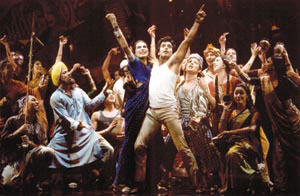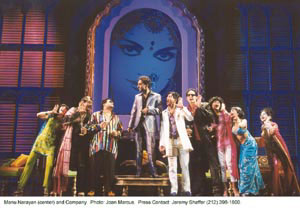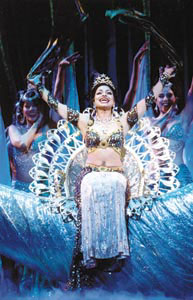Arts
Past Dream Time

It's Showtime For Bombay Dreams.
|
From the first opening moments as the skyscrapers and slums of the City by the Sea float eerily into focus, as human forms populate the space and as A.R. Rahman’s dramatic orchestral score rises to a crescendo, you know you’re in for a big, fat Bollywood experience. Exuberant India with its overpowering dichotomies and colors, its rhythms and cacophonies, its Ganesh festivals, dancing hijras and, of course, its beloved Bollywood film industry is finally being showcased on Broadway!
Bombay Dreams, which is based on an idea by Shekhar Kapur and Andrew Lloyd Webber, and written by London writer/actress Meera Syal, has been a hit in London’s West End. The musical about a young man from the slums who dreams of becoming a Bollywood star has now sailed into New York, remaking itself in the process. The New York version is scripted by Meera Syal and Thomas Meehan, who has created major Broadway hits like The Producers and Hairspray. The music is by that amazing musical phenomenon A.R.Rahman, and new songs have been added for the New York production. The cast of 39 is headed by Manu Narayan as Akaash and Anisha Nagarajan as Priya, both making their Broadway debut, and also includes Ayesha Dharker, Sriram Ganesan, Marvin L. Ishmael, Deep Katdare and Madhur Jaffrey. Bombay Dreams had a glitzy opening night with the paparazzi going wild outside the Broadway Theater as Andrew Lloyd Webber, A.R.Rahman, Donald Trump, Ismail Merchant and James Ivory, Padma Lakshmi (minus Rushdie) and a host of other celebs smiled and posed. Next morning came the reviews, and they weren’t all kind, the review in The New York Times being particularly scathing. While the frothy parody got mixed reviews in London’s West End too, it went on to become a success and is still playing after two years. Syal, who wrote the London version, worked with Meehan for over 18 months, reshaping it for the American audience. “The basic story is actually the same, but we felt we had to make it more accessible to American audiences who are very different from British audiences, who know a lot more about South Asia and Bollywood,” she said.
“We had to get rid of a lot of the in jokes and the parody and make it a lot clearer really, so people who don’t know anything about Bollywood could still walk into the show and really enjoy it.” She added, ” I think it’s a very classic story, a very rags to riches story about a young man who wanted to be a star, the same as Saturday Night Fever or the same as Gypsy – the same as a lot of very classical American stories. So I think it should work very well.” Indeed, Bollywood song and dance extravaganzas and Broadway musicals aren’t really that different from each other. As Meehan observed: “There are some thrilling, thrilling moments in the show including Shakalaka Baby where the water from the fountain spouts up 30 feet into the air and everybody just gets soaked and they keep on singing and dancing and the audience just loves it! It’s one of the most thrilling numbers on Broadway in years, I think. It’s true Bollywood.” So do audiences share the critics’ verdict? The night we caught Bombay Dreams, it was a full house and while there were some South Asians present, the crowd was overwhelmingly mainstream. They were a good audience. They clapped enthusiastically after each of the solo numbers, laughed at all the jokes and yes, in the end, some were even dancing in the aisles. We eavesdropped shamelessly as the crowds moved out after the show. “Great dancing,” “Gorgeous clothes” and “It was fantastic!” were some of the comments. As we waited curbside, we struck up a conversation with Robin Savage, a tax attorney in Manhattan, who had just seen the show with her friend Julie Zhang. Her response: “Fabulous! I loved it! I think there were times when you could tell the actors are relatively new to Broadway, but the dancing more than made up for that. It was just a fun musical to see.”
Savage had come to see the show despite the reviews, and pointed out that another show, Wicked, which also opened recently to lukewarm reviews, had really picked up by word of mouth. And that may certainly happen with Bombay Dreams. “I absolutely think word of mouth will help this show tremendously,” she said. “I was in the park and saw a girl wearing a Bombay Dreams tee shirt and asked her what she thought about it and her response mirrored my feeling about the show. Most of the people I have talked to who have seen it, loved it. I am telling everyone I know who enjoys theater to go see it.” Indeed, the action never stops in this high energy musical: The cast seems to be fitted with rechargeable batteries, singing and dancing with all their heart even at curtain call, and the dhol musicians perched high up on balconies flood the hall with gorgeous music even as the audience is headed out of the hall. Bombay Dreams is a first introduction for people who’ve never been to India – the wedding scene with its rich ochres and magentas and reds captures it well – and the costumes are sumptuous. A.R.Rahman’s music! It has to stick in people’s heads and come back to haunt them at the most inopportune times. Try preparing a business report while Shakalaka Baby drums incessantly in your brain! Little surprise then that Bombay Dreams has been nominated for three Tonys – best costume design, best orchestrations and best choreography. Margery Singer, whose company has handled the marketing of over 50 Broadway shows, has used multiple strategies to reach both the traditional theatergoers and South Asian audiences. “Most certainly we tapped into the South Asian market whereas we never or very infrequently would do that,” says Singer. “We’ve got great support from the community, but for us to succeed on Broadway we needed to tap into the traditional theatergoer; we could not depend on just the South Asian audience. So in many cases we marketed and promoted it in the same manner that we traditionally do, and expanded it a bit.” Sudhir Vaishnav, associate producer of Bombay Dreams, is probably the first Indian to have a finger in the Broadway pie. He had produced A.R. Rahman’s New York show in 2000 and got introduced through him to Andrew Lloyd Webber and Waxman-Williams Entertainment, the local producers of Bombay Dreams. Ask him about the response and he says, “There’s been excellent word of mouth and in spite of mixed reviews, we haven’t had any negative results. We are practically full every night and we are booked solid through July end.” He points out that the audience for Bombay Dreams is about 70 percent mainstream and 30 percent South Asian, bringing in a whole new audience to Broadway. The advance sales have been strong, he says, and he plans to reach various South Asian organizations. Non-profit organizations like American India Foundation and Children’s Hope India have already held Bombay Dreams fundraisers, drawing South Asian audiences. Summer will also bring Bombay Dreams into the open, perhaps with advertising on hoardings and buses, and come September thousands of Republicans in town for their national convention will see Bombay Dreams, one of the ten plays selected for them.
Then there is New York’s huge, constantly changing tourist population – people who are surely going to be moved by the magic of the Andrew Lloyd Weber name and the fact that Bombay Dreams comes after a successful run of over two years in London’s West End. Webber reportedly liked the U.S. changes in the production so much that he’s closing the London show in June, taking it on tour and then opening up around December with the U.S. version. “The music, the choreography, the costumes, the sets, people love it,” says Vaishnav. “So far every night we’ve been having standing ovations, so it proves it’s a crowd-pleaser. We are amazed at the mix of the audience – that is typical Rahman – from children to grandparents, which is not just the usual Broadway crowd.” He adds, “Basically the critics have to change with the times. They have to accept something new, a combination of something young and energetic and foreign. They have to keep an open mind. ” For the first time young South Asian performers have got their place in the Broadway sun and as Meehan, a veteran of award-wining Broadway productions, says, “They’ve given hundred percent. It was thrilling for me as an older American who’s worked in a lot of shows to see the energy and the excitement and the glow in their eyes – the terrific talent that they all have.” Madhur Jaffrey perhaps summed it up best after the heady applause of opening night: “As South Asians, we’re not used to seeing ourselves on Broadway at all, and it makes me weep really to see all of us up there and everyone enjoying one aspect of our culture. It’s never been there before and so many of us are working. I love that. This thrills me. I’ve been around so long and for me to see this, I thank the Lord it’s happened in my time. This is a first. We needed a first to take place.” |




